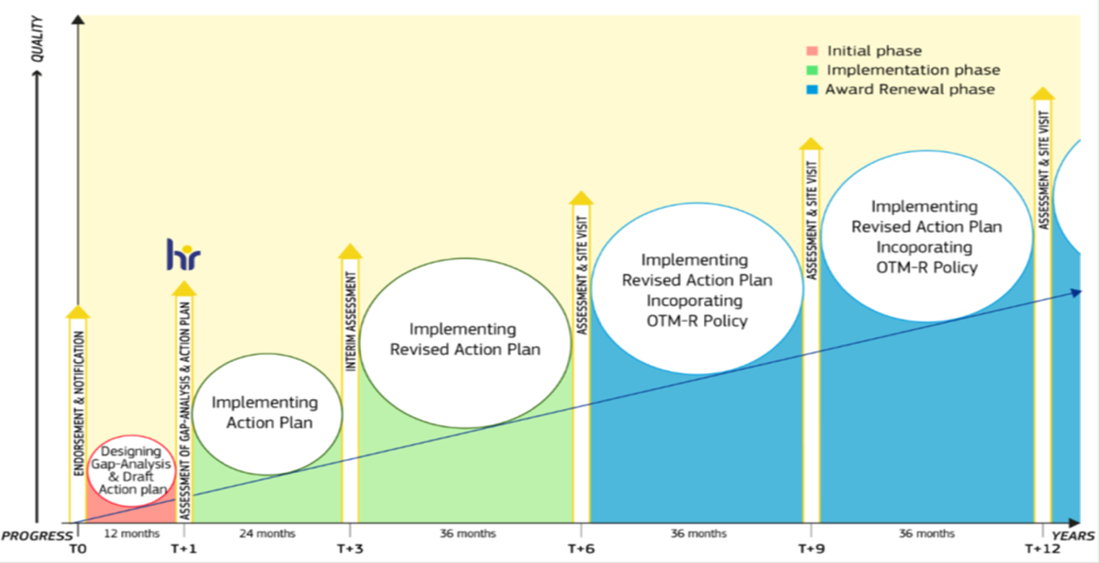Introduction
1. THE INSTITUTION: THE MIGUEL HERNÁNDEZ UNIVERSITY (UMH)
The Strategic Plan is a useful tool for designing the future policies that will guide our collective actions for the next few years.
The UMH’s quality of management has been recognised with several awards and honours.



The guidelines of the ISO 9001 standard are also followed by the Research Management Service, whose mission is to boost and strengthen the research work of the UMH as well as encouraging the promotion and transfer of the generated knowledge and results in society.
- KEY DATA OF THE UMH
| STAFF & STUDENTS | FTE |
| Total researchers = staff, fellowship holders, bursary holders, PhD, students either full-time or part-time involved in research. | 693 |
| Of whom are international (i.e. foreign nationality) | 34 |
| Of whom are externally funded (i.e. for whom the organisation is a host organisation) | 33 |
| Of whom are women | 272 (39.3 %) |
| Of whom are stage R3 or R4 = Researchers with a large degree of autonomy, typically holding the status of Principal Researcher or Professor | 350 |
| Of whom are stage R2 = in most organisations corresponding with postdoctoral level. | 196 |
| Of whom are stage R1 = in most organisations corresponding with doctoral level | 147 |
| Total number of students (is relevant) | 13,002 |
| Total number of staff (including management, administrative, teaching and research staff) | 1,875 |
UMH INDICATORS (October 2018)
- The total number of staff is 1.875 (693 researchers)
- 31 Service departments and administrative units
- 7 Faculties (Fine Arts, Experimental Sciences, two for Social and Legal Sciences, Social and Health Sciences, Pharmacy and Medicine)
- 2 Polytechnic Schools
- 4 University Research Institutes
- 9 Research centres
- 20 Academic departments
- 8 Institutional chairs
- 18 Research chairs
- 99 Research groups
There are a total 25 degrees, 46 master’s degrees and 13 doctoral degrees on offer
2. WHAT IS THE EUROPEAN CHARTER FOR RESEARCHERS AND THE CODE OF CONDUCT FOR THE RECRUITMENT OF RESEARCHERS?
In March 2005, the European Commission approved Recommendation 2005/251/EC on “The European Charter for Researchers and the Code of Conduct for the Recruitment of Researchers” and established the 40 principles that define the rights and responsibilities of researchers, institutions and funders of research across Europe. These principles were sorted into four categories: Ethical and Professional Aspects, Recruitment and Selection, Working Conditions and Social Security, and Training and Development.
These two documents are key pieces of the European Union’s policy to make research an appealing career, as an essential part of the strategy to stimulate the economic growth of the EU.
The European Charter for Researchers describes the roles, responsibilities and entitlements of researchers and their employers. The objective is to ensure that the relation between these two parties contributes towards a successful performance in the generation, transfer and shared use of knowledge, as well as the professional development of the researchers from the first phases of their contract, and to create an appealing European labour market for researchers.
The “Code of Conduct for the Recruitment of Researchers” aims to improve recruitment and ensure that the selection processes are fair and transparent.
3. WHAT IS THE HRS4R (HUMAN RESOURCE STRATEGY FOR RESEARCHERS)?
EURAXESS is a European initiative that offers a comprehensive range of information services and offers support for researchers who wish to carry out their research careers in Europe, as well as for those who want to stay linked to European research activities.
Thus, the “Human Resource Strategy for Researchers” (HRS4R) established by EURAXESS provides support for the implementation of the principles of the Charter and Code, as well as monitoring the process of granting the “HR Excellence in Research” award.
The “Human Resource Strategy for Researchers” (HRS4R) helps research institutions and funding entities implement the Charter and Code in their policies and practices by way of the procedure for the implementation of the Human Resources Strategy for Researchers (HRS4R)
It is a transparent approach which provides easily accessible public information on the actions that partaking institutions and organisations must conduct in order to put the principles of the Charter and Code into practice.
(HRS4R = Human Resource Strategy for Researchers)
4. WHAT IS THE PROCEDURE TO OBTAIN THE EUROPEAN COMMISSION’S RECOGNITION?
1º The institution sends a letter to the European Commission informing that it is adhering to the principles of the Charter and Code and commits to implement them
2º There is a period of one year from the date of adhesion to develop a Gap Analysis which analyses the potential deficiencies that its human resource policies may have, as well as an Action Plan with the actions planned to overcome these deficiencies and align them with the Charter and Code
3º The public institution publishes these documents (Gap Analysis and Action Plan) on their website
4º The institution sends them to the European Commission to be assessed
5º If the assessment is positive, the Commission adds the institution to the list of institutions that are committed to complying with the Charter and Code
6º The Commission awards the institution the “HR EXCELLENCE IN RESEARCH AWARD”
7º An interim assessment takes place two years later for monitoring purposes
8º This assessment verifies the implementation of the Action Plan
9º Five years later, an award renewal assessment is conducted
10º From then on, there are assessments every three years


